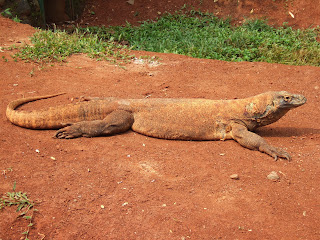 The Komodo dragon (Varanus komodoensis) is a venomous species of lizard that inhabits the islands of Komodo, Rinca, Flores, and Gili Motang in Indonesia. A member of the monitor lizard family, it is the largest living species of lizard, growing to an average length of 2 to 3 metres (6.6 to 9.8 ft) and weighing around 70 kilograms (150 lb). Their unusual size is attributed to island gigantism, since there are no other carnivorous animals to fill the niche on the islands where they live, and also to the Komodo dragon's low metabolic rate. As a result of their size, these lizards dominate the ecosystems in which they live.
The Komodo dragon (Varanus komodoensis) is a venomous species of lizard that inhabits the islands of Komodo, Rinca, Flores, and Gili Motang in Indonesia. A member of the monitor lizard family, it is the largest living species of lizard, growing to an average length of 2 to 3 metres (6.6 to 9.8 ft) and weighing around 70 kilograms (150 lb). Their unusual size is attributed to island gigantism, since there are no other carnivorous animals to fill the niche on the islands where they live, and also to the Komodo dragon's low metabolic rate. As a result of their size, these lizards dominate the ecosystems in which they live.Komodo dragons are carnivores. Although they eat mostly carrion, they will also ambush live prey with a stealthy approach, a technique that has allowed the Komodo dragon to capture even the most lethal prey, such as the King Cobra. When suitable prey arrives near a dragon's ambush site, it will suddenly charge at the animal and go for the underside or the throat. It is able to locate its prey using its keen sense of smell, which can locate a dead or dying animal from a range of up to 9.5 kilometers (6 miles). Komodo dragons have also been observed knocking down large pigs and deer with their strong tail. Komodo dragons eat by tearing large chunks of flesh and swallowing them whole while holding the carcass down with their forelegs. For smaller prey up to the size of a goat, their loosely articulated jaws, flexible skull, and expandable stomach allow it to swallow its prey whole. Copious amounts of red saliva that the Komodo dragons produce help to lubricate the food, but swallowing is still a long process (15–20 minutes to swallow a goat). Komodo dragons may attempt to speed up the process by ramming the carcass against a tree to force it down its throat, sometimes ramming so forcefully that the tree is knocked down. To prevent itself from suffocating while swallowing, it breathes using a small tube under the tongue that connects to the lungs. After eating up to 80 percent of its body weight in one meal, it drags itself to a sunny location to speed digestion, as the food could rot and poison the dragon if left undigested for too long. Because of their slow metabolism, large dragons can survive on as little as 12 meals a year.



No comments:
Post a Comment